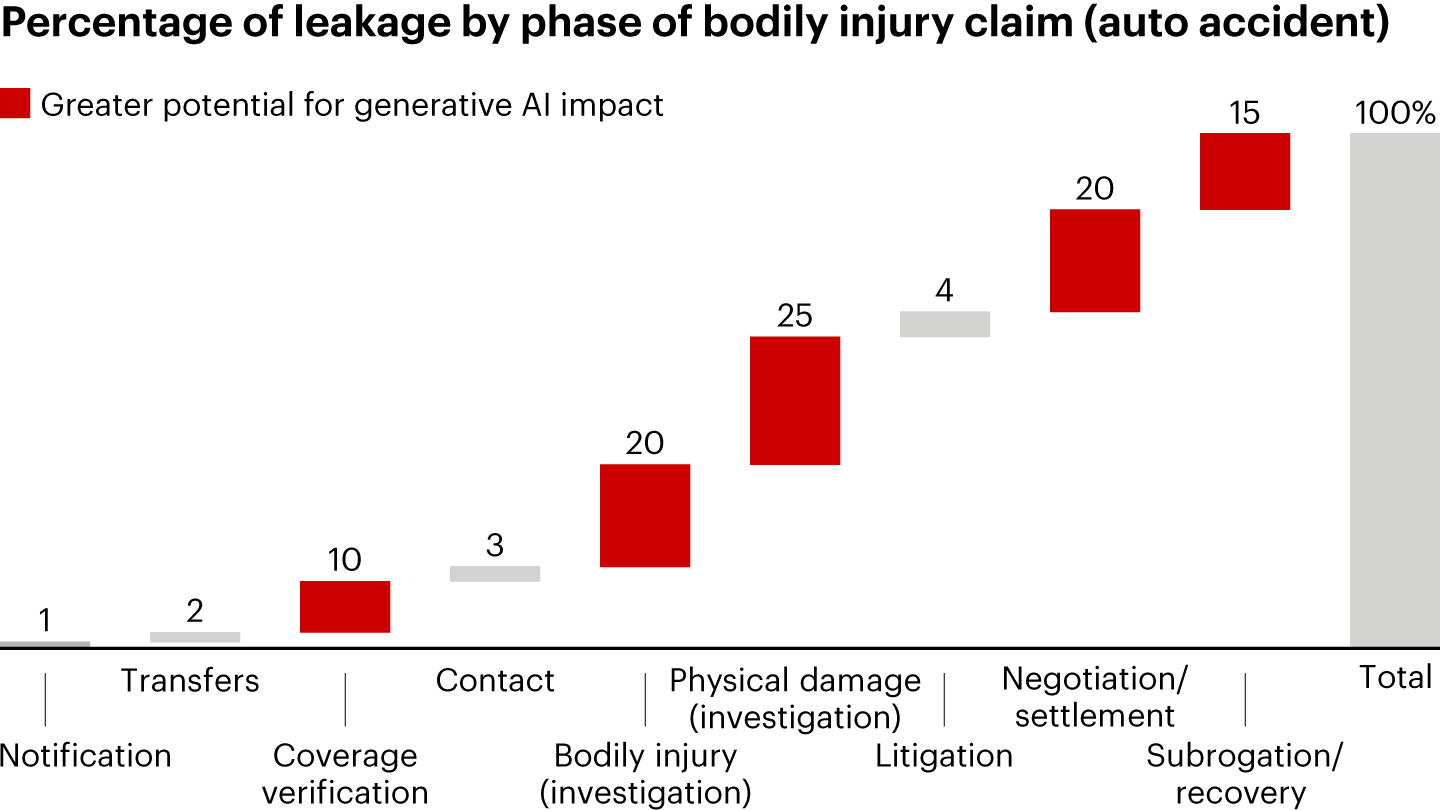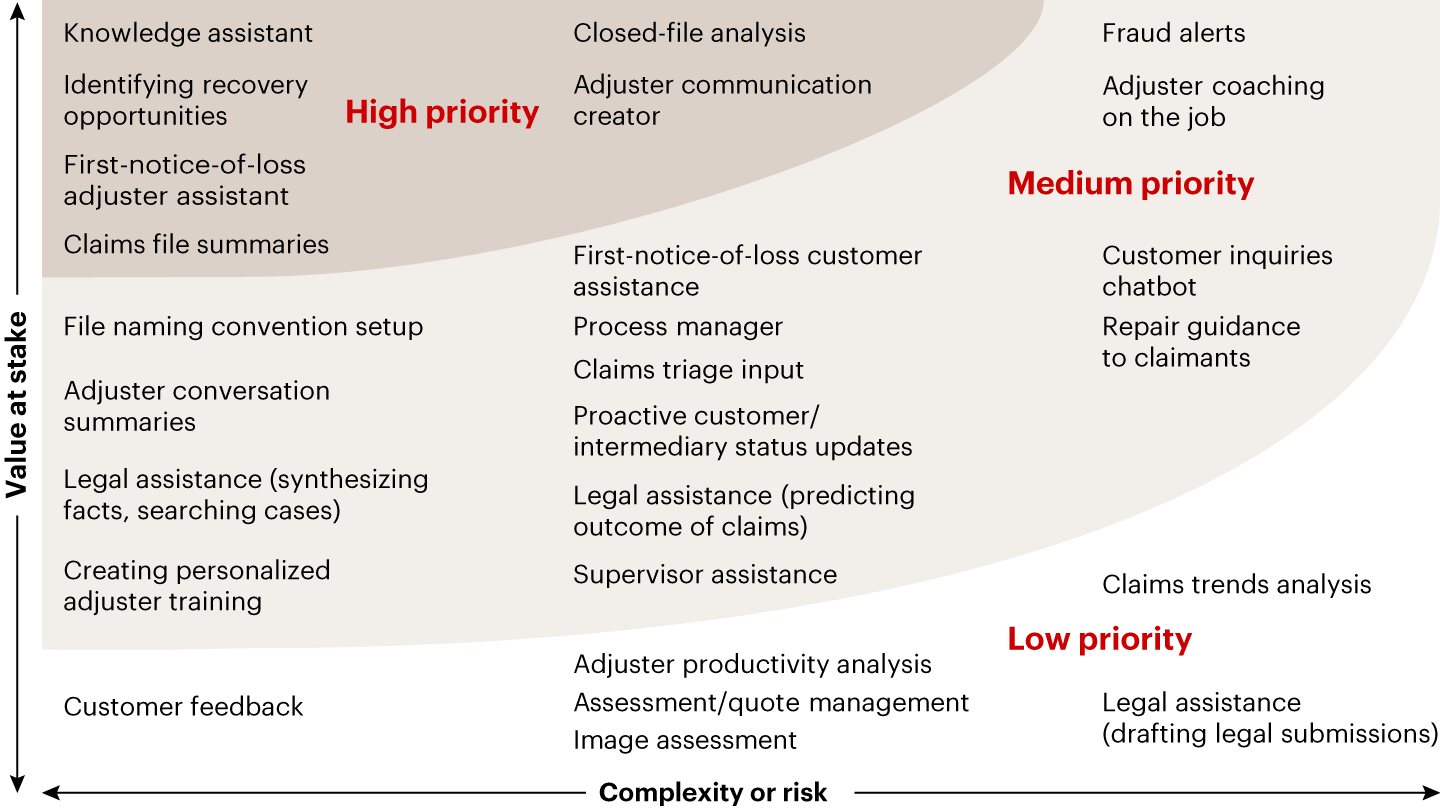Brief

Executive Summary
- With its heavy procedures and unstructured data, claims handling provides fertile ground for insurers piloting generative AI technology.
- We estimate that the technology could reduce loss-adjusting expenses by 20% to 25% and leakage by 30% to 50%, creating more than $100 billion in benefits for insurers and customers.
- But this can only happen if insurers scale up successful initiatives, which will require organizational change and new capabilities.
Claims is where the rubber meets the road for insurance companies. Negotiating a claim is a moment of truth for customers, with an outsize influence on whether they become promoters or detractors of the insurer. It is also the most costly insurer operation, thanks to the large pool of employees and the payouts involved. And given the high inflation, supply chain disruptions, and extreme weather events of recent years, costs have been climbing.
Advances in generative artificial intelligence hold substantial promise to bend the curve on productivity, after years of hopes for robotic process automation and other digital tools that haven’t fully materialized. Now the technology looks set to reduce costs and improve the claims experience for both customers and employees. In addition, it could offer greater integrity and control of core processes by catching exceptions and leakage faster.
Many companies have begun to experiment with the technology. Zurich is feeding six years of claims data into generative AI models to identify specific causes of loss and improve underwriting. A South American insurer developed a generative AI pilot for claims management that offers voice-to-text transcription to fill out forms, summaries of claims information, drafts of customer communications, and a chatbot to help agents answer queries. Early results are strong, including a productivity increase of up to 50% for the relevant tasks and a potential 40% reduction in leakage. An insurer in Asia-Pacific achieved a similar reduction in coverage-related leakage and a 10- to 20-minute time savings per claim by using generative AI for coverage validation.
The outlook for creating value in property and casualty (P&C) claims spans several themes:
- Customer experience. Generative AI assistants will help employees deliver better experiences. Humanlike virtual assistants will be increasingly deployed to deliver on-demand customer service in more complicated situations, tailored to an individual customer’s claim.
- Claims payout accuracy. Payouts will become more accurate through easier coverage verification, more efficient investigations, and better negotiations based on past case analysis.
- Adjuster and contact-center agent productivity. Combined with other technologies, generative AI will reduce the time employees spend on administrative tasks and basic handling, freeing them up for more valuable work such as supporting customers and processing complex claims.
- Litigated claims. Generative AI will quickly summarize demand packages from plaintiffs, helping determine whether to fight or settle based on coverage and jurisdictional histories. As more court and police records are digitized, litigation support will be a rich environment for generative AI.
- Employee experience. The Covid-19 pandemic contributed to massive turnover in the claims workforce. Further, an ALM Intelligence survey found that nearly one-quarter of US adjusters anticipate retiring within the next few years. Enhanced training provided by generative AI will help inexperienced employees get up to speed more quickly, while copilot assistance will allow for constant active coaching.
Looking at the cost side of the equation, some 65% of insurers surveyed by Reuters consider technology, including generative AI, the best approach to addressing rising claims costs. We estimate that generative AI at its full potential could lead to a 20% to 25% decrease in P&C claims loss-adjusting expenses. Savings will come in part from enabling handlers to more efficiently locate and connect policy and claimant information. The tools can transcribe calls, nudge handlers, draft follow-up emails, and initiate internal processes. Chatbots or voicebots will augment or replace employees who gather information from claimants in the initial contact and fact-gathering stage.
In parallel, we anticipate that generative AI will spur a 30% to 50% decrease in total leakage—the difference between what is paid vs. what is owed per the contract, which occurs when adjusters deviate from policy guidelines or when supply chain problems cause unanticipated costs (see Figure 1). Insurers currently address leakage through audits of closed files, but manual audits are tedious and can cover only a sample of files. Generative AI will be able to handle a large volume of past claims and settlements, recognizing patterns useful in guiding veteran adjusters and training new ones.


The technology will access information about policyholder coverage more efficiently, helping reduce instances of indemnity payments to people who lack appropriate coverage. Similarly, fast access to information about past negotiations will make for greater accuracy in current negotiations.
In total, the decrease in loss-adjusting expenses and leakage could create more than $100 billion in economic benefits globally, shared as insurer profits and lower customer rates. Moreover, the technology could reduce the effort spent on humans monitoring humans, both in terms of typical supervisory spans in claims units and in reviews of files that have been closed, which would become open-file reviews.
Mind the risks
To be sure, obtaining these results will take time, a thoughtful strategy, and disciplined execution. Generative AI tools are relatively easy to experiment with but harder to scale up. As with any nascent technology, there are several risks to consider, including concerns around accuracy and fairness; explainability of outputs to employees, customers, and regulators; transparency and traceability of models; fraud attempts with AI-generated photos; and privacy of customer data.
Accommodating generative AI also involves new ways of working for employees. The claims organization tends to be one of the most entrenched in procedures and practices, operating on an apprenticeship type of model that values proven step-by-step processes. A generative AI copilot that systematizes knowledge may eliminate some of the adjuster’s traditional steps, which could raise concerns among longtime employees.
Given the risks and sustained investment involved, insurers should start with simple but high-value use cases where risk can be managed with human oversight, such as a knowledge assistant, claims file summaries, or a first-notice-of-loss adjuster assistant. Experience with those use cases will set the stage for rolling out more complex internal use cases and simple external ones, such as adjuster coaching on the job (see Figure 2). Then insurers will be positioned to set up complex external use cases, such as a virtual claims assistant.


Two routes to scaling up
With any use case, attaining large scale is essential to realizing substantial benefits. Currently, 41% of financial services companies recently surveyed by Bain & Company are using generative AI at full production, rather than piloting it. Insurers can scale up through two routes:
- Through similar types of use cases. Once the first use case of an archetype is built, it can be replicated quickly and inexpensively by reusing technologies and methodologies. This avoids a proliferation of shadow IT and makes for faster deployment in all the descendant use cases. A knowledge assistant, for instance, could perform many of the tasks related to policy information, coverage verification, details in the claims file, and new adjuster training.
- Within a workflow. Combining multiple use cases within a workflow can optimize processes, leading to cost efficiencies and overall improvement in the customer experience. For example, call summarization, call reason analysis, and call insights and follow-up can collectively transform the workload of a claims adjuster and raise productivity. Focusing on one workflow allows organizations to more effectively allocate resources, prioritize initiatives, manage dependencies, and pinpoint accountability.
How to get started
For companies that have just launched small pilots, the history of traditional AI and previous technologies suggests guidelines for senior leaders to steer the claims organization.
Pan for nuggets of gold. Use cases that have clear value, are simple, and meet the organization’s risk tolerance should get the first look. These applications hit the cash register and earn the right to unlock investments for more transformative initiatives.
Sort out what to build and what to buy. Vendors are incorporating generative AI into their solutions, so claims organizations have to stay abreast of the market, separating fact from fiction and making educated guesses on who the winners and losers will be. With so many established solutions, it can be a waste of time to, for instance, build a summarization tool or a bespoke data extraction tool. Proprietary solutions should be limited to cases of high strategic importance and high complexity or risk, such as employee-facing use cases that significantly improve the customer or employee experience. Cases of lower strategic importance and risk can be handled with third-party solutions.
Devise rapid experiments using different testing methodologies. A test-and-learn approach informs decisions about how to wring the most value from each initiative. Engage claims managers and frontline employees to test solutions and evaluate them for completeness and accuracy.
Set up joint business-technical teams. Collaboration is crucial to ensure that solutions meet user needs and are technically feasible. Frontline employees are sensitive to the structure and form of responses. Depending on the type of query, a response should match a set logic flow and include the right degree of detail in the right tone.
Inspire people to want to adopt. Involve the entire claims team early on and in each step of the process. Besides ongoing training for employees, respected generative AI champions can help accelerate adoption by communicating how the technology can improve ways of working.
Imagining a different future
Plenty of hype surrounds generative AI. However, it’s reasonable and useful for insurers to think big in their ambitions for transforming claims operations.
Imagine, for instance, if adjusters could use the technology to have a full claims history displayed instantly, along with the ability to search an AI knowledge base and get an initial draft of answers to customers’ questions. They could call up a quick summary of claims file data. And they could rely on a copilot to provide suggestions based on past outcomes.
Or imagine if claims supervisors could get actionable analytics, tracking indicators, and a rapid read on adjuster responses and tone, as a guide to improve performance.
Imagine if customers could turn to a chatbot for accurate claims status updates and instant responses to questions.
Big ambitions can motivate people in claims. Careful execution of experiments, with an eye to scaling up the successes, will keep the organization on track to reaching those ambitions over time. Generative AI is a powerful tool but a tool nonetheless, so striking the right balance between human and machine in allocating work will ultimately determine how much competitive advantage an insurer can build in claims.